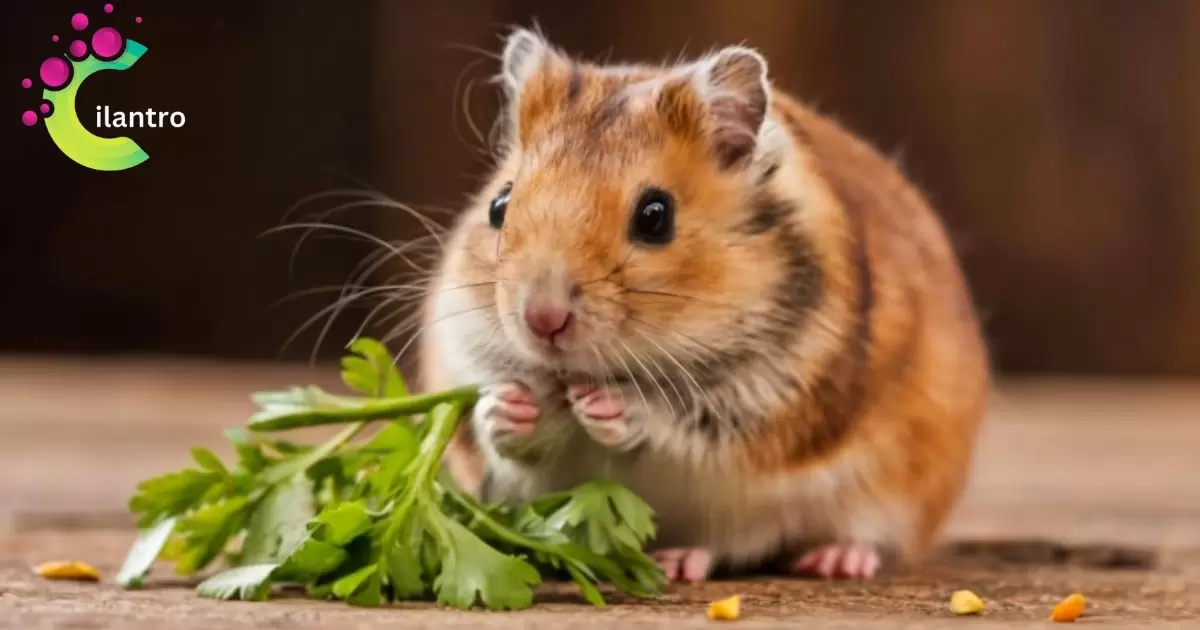Yes, hamsters can eat cilantro in moderation as an occasional treat. It’s a safe and healthy herb that adds variety to their diet.
Hamsters are adorable, pocket-sized pets that bring joy and companionship to many households. The question that arises is can hamsters eat cilantro? They absolutely can! Cilantro, with its fresh and vibrant flavor, adds a tasty twist to your furry friend’s meals. We will delve into the nutritional aspects of cilantro, its potential benefits and risks for hamsters, and how to safely incorporate it into their diet.
As responsible pet owners, it’s crucial to provide them with a well-balanced diet to ensure their health and happiness. Cilantro provides a fresh flavor and some nutrients for them. Too much cilantro can lead to digestive issues for hamsters.
A small amount of cilantro is perfect to keep your hamster happy and healthy. So, go ahead and introduce this delightful herb into their diet for a happy hamster munching experience.
In this article, we discuss more interesting and beneficial things, so stay tuned with us!
Understanding the Nutritional Profile of Cilantro
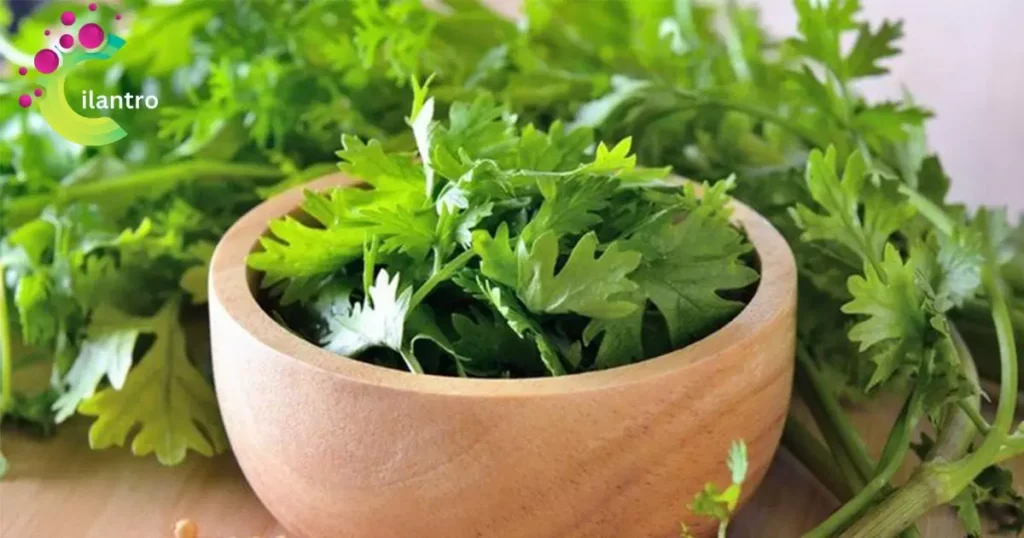
Before we explore whether hamsters can consume cilantro, let’s take a closer look at the nutritional profile of this herb. Cilantro is rich in various vitamins and minerals. To enjoy its benefits beyond mere consumption, it can also be used to make cilantro tea. It contains essential nutrients such as:
Rich Vitamins
Cilantro is a good source of vitamins A, C, and K. These vitamins play vital roles in maintaining a hamster’s overall health, including immune function, vision, and blood clotting.
Minerals
It contains minerals like potassium, calcium, and phosphorus, which contribute to bone health, muscle function, and overall well-being.
Antioxidants
Cilantro is packed with antioxidants, including beta-carotene and quercetin. These compounds help combat oxidative stress and may contribute to cellular health.
Fiber
Hamsters require fiber for proper digestion, and cilantro provides a small but beneficial amount to support their digestive system.
Do Hamsters like Cilantro?
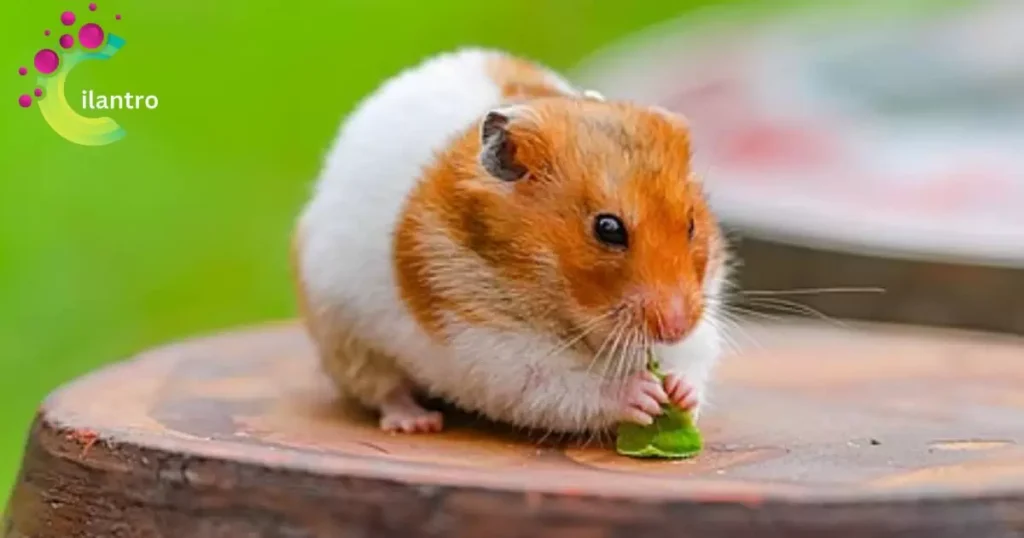
Hamsters can enjoy cilantro as a tasty treat. Hamsters Eat Cilantro? Cilantro is a safe herb for them to eat in moderation. It adds variety to their diet and can be a healthy snack. To feed cilantro to your hamster, make sure it is fresh and thoroughly washed.
Chop it into small, manageable pieces to prevent choking. Remember, while cilantro is fine for hamsters, it’s essential to offer a balanced diet with a mix of vegetables, fruits, and hamster pellets for their overall well-being.
How Should I Feed Cilantro to My Hamster?
Feeding cilantro to your hamster is easy and healthy. Start by washing the cilantro thoroughly to remove any pesticides or dirt. Hamsters Eat Cilantro. Chop it into small, bite-sized pieces that your hamster can easily handle. Offer a small amount initially to see if your hamster likes it.
If they enjoy it, you can include cilantro as part of their balanced diet, but moderation is key. Too much cilantro can lead to digestive issues, so be sure to provide a diverse range of foods to keep your hamster happy and healthy.
How to Introduce Cilantro to Your Hamster’s Diet
Introducing cilantro to your hamster’s diet can be a tasty and nutritious addition to their meals. Hamsters eat cilantro. Start by offering a small amount of fresh cilantro alongside their regular food. Gradually increase the amount to see how your hamster reacts.
Monitor their response and make sure they enjoy the new treat. If you’ve decided to incorporate cilantro into your hamster’s diet, here are some guidelines to ensure a smooth introduction:
Start Gradually
Introduce cilantro slowly, starting with a small amount. This allows your hamster’s digestive system to adjust to the new food.
Observe Behavior
Monitor your hamster’s behavior after introducing cilantro. Look for signs of enjoyment, indifference, or any negative reactions.
Chop into Small Pieces
Cut cilantro into small, manageable pieces to prevent choking and make it easier for your hamster to eat.
Rotate with Other Foods
While cilantro can be a healthy addition, it should not replace the staple hamster diet. Rotate the cilantro with other fresh vegetables, fruits, and high-quality hamster pellets.
Assessing the Safety of Cilantro for Hamsters: Hamsters Eat Cilantro
Now that we understand the nutritional content of cilantro, let’s explore whether it’s safe for hamsters to consume. In general, hamsters eat cilantro, which is considered safe for hamsters when given in moderation. However, there are a few factors to consider:
Pesticides and Washed Produce
When offering cilantro to your hamster, make sure it’s thoroughly washed to remove any pesticides or contaminants. Organic cilantro can be a good choice to minimize the risk of harmful chemicals.
Moderation is Key
While cilantro provides essential nutrients, it should be given in moderation. Too much of any food, including cilantro, can lead to digestive issues in hamsters.
Allergies
As with any new food, monitor your hamster for signs of allergies or adverse reactions. If you notice any unusual behavior, digestive problems, or changes in stool, it’s advisable to consult a veterinarian.
Potential Benefits of Cilantro for Hamsters
Cilantro can offer several potential benefits for hamsters when included as part of a balanced diet:
Nutrient Boost: The vitamins and minerals in cilantro can contribute to your hamster’s overall nutrient intake, supporting their health and well-being.
Digestive Health: The fiber content in cilantro may aid in digestion, helping prevent constipation and promoting a healthy digestive system.
Variety in Diet: Offering a variety of foods, including herbs like cilantro, can prevent dietary monotony and encourage a more well-rounded diet for your hamster.
Foods to Avoid Giving Hamsters
Here’s a table of 10 points listing foods to avoid giving to hamsters:
| No. | Food to Avoid for Hamsters | Reason |
| 1 | Citrus fruits (oranges, lemons) | High acidity can upset their digestive system. |
| 2 | Onions and garlic | These can be toxic and lead to digestive issues. |
| 3 | Chocolate | Contains theobromine, which is toxic to hamsters. |
| 4 | Almonds and other nuts | High in fat, which can lead to obesity and other health issues. |
| 5 | Sugary or salty snacks | Can cause obesity and other health problems in hamsters. |
| 6 | Processed or sugary foods | Hamsters have sensitive digestive systems; these can be harmful. |
| 7 | Human sweets and candies | High sugar content is not suitable for hamsters’ health. |
| 8 | Spicy foods | Hamsters cannot tolerate spicy ingredients; they can harm them. |
| 9 | Raw kidney beans | Contain toxins that can be harmful to hamsters if not cooked. |
| 10 | Dairy products | Hamsters are lactose intolerant; dairy can cause digestive issues. |
Remember, a well-balanced hamster diet should primarily consist of commercial hamster food mixes, supplemented with fresh vegetables and fruits in moderation. Always check with a veterinarian if you’re uncertain about the suitability of a particular food for your hamster.
Advantages of Feeding Cilantro to Your Hamsters
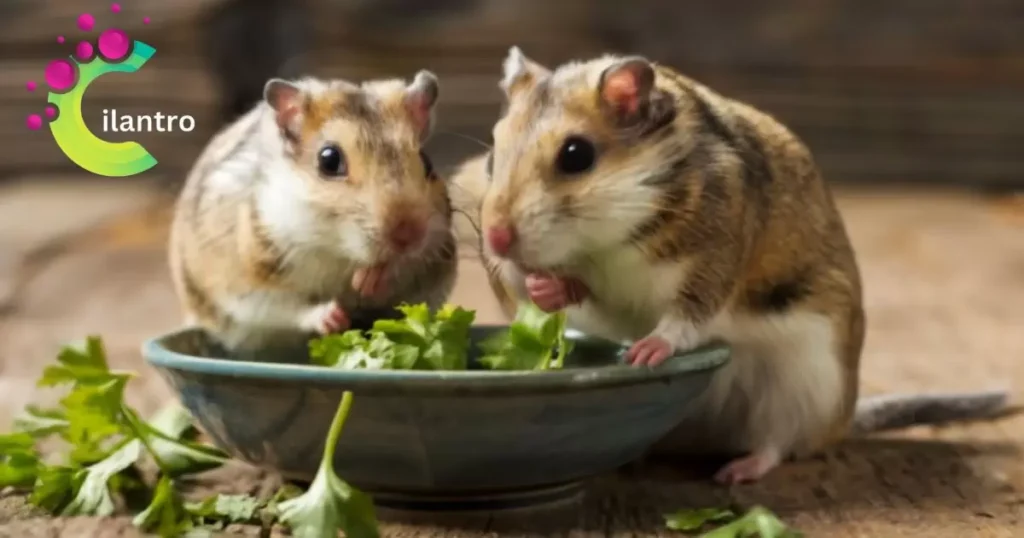
- Cilantro is a nutritious herb that benefits your hamster’s health.
- Rich in vitamins and minerals, it supports their overall well-being.
- The fresh and flavorful nature of cilantro adds variety to their diet.
- It helps promote a shiny coat and strong immune system.
- Hamsters often enjoy the taste, making it a favorite treat for them.
- Introducing cilantro in moderation can enhance your hamster’s diet diversity.
Hamster Species and Individual Variations
Different species of hamsters may have varying dietary requirements. Syrian hamsters, for example, have slightly different needs compared to dwarf hamsters. Hamsters eat cilantro, and incorporating this herb into their diet can contribute to a well-balanced nutrition plan for these small pets.
Individual hamsters may react differently to certain foods. It’s essential to pay attention to your hamster’s specific preferences and any signs of discomfort or allergies.
Cilantro and Hydration
Cilantro has a high water content, which can contribute to your hamster’s overall hydration. While hamsters primarily obtain water from their drinking bottles, hamsters eat cilantro, incorporating water-rich foods like cilantro can be an additional source of moisture.
Proper hydration is crucial for their well-being, supporting various bodily functions, including digestion.
Herbs and Enrichment
Beyond nutritional benefits, introducing herbs like cilantro can serve as a form of environmental enrichment for your hamster. Hamsters are naturally curious and enjoy exploring new textures and flavors.
Providing a diverse range of foods, including herbs, can stimulate their senses and promote mental well-being.
Consulting a Veterinarian

If you’re uncertain about whether to include cilantro in your hamster’s diet or if you notice any changes in behavior or health, it’s advisable to consult with a veterinarian.
A vet can provide personalized guidance based on your hamster’s age, health status, and specific nutritional needs. They may also offer recommendations for commercial hamster food brands that meet your pet’s requirements.
Guidelines and Risks Associated with Feeding Cilantro to Your Hamster
- Offer cilantro in small, bite-sized pieces to prevent choking hazards.
- Wash and ensure cilantro is free from pesticides before feeding.
- Moderation is key; excessive amounts may lead to digestive issues.
- Monitor for any signs of allergies or adverse reactions in your hamster.
- Rotate cilantro with other vegetables to maintain a balanced diet.
- Consult with a vet if you have concerns or observe unusual behavior.
What are other Healthy Alternatives to Cilantro in a Hamster’s diet?
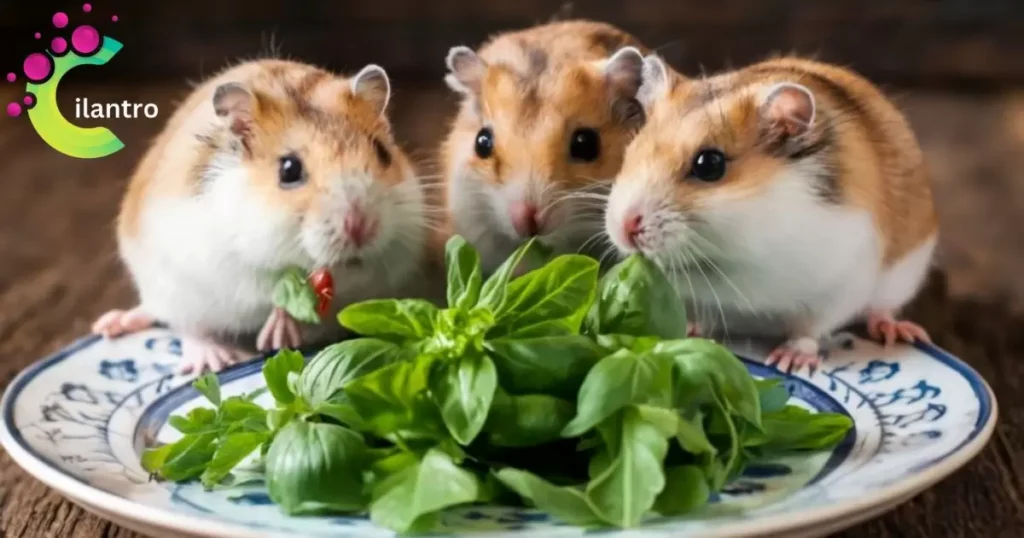
Parsley: It is a nutritious substitute for cilantro in a hamster’s diet. It provides essential vitamins and minerals, promoting overall health.
Dill: It is a flavorful herb that hamsters enjoy and is a safe alternative to cilantro. It adds variety to their diet and is rich in antioxidants.
Basil: It can be a tasty and healthy replacement for cilantro. It offers vitamins and has anti-inflammatory properties that support hamster well-being.
Mint leaves: They are a refreshing option that hamsters find appealing. Mint also aids in digestion and can be a suitable cilantro alternative.
Chervil: It is a mild herb that can be included in a hamster’s diet. It contributes to their nutritional intake without causing harm.
Coriander leaves: They are from which the plant cilantro comes, can be used as a substitute. While the flavor is similar, some hamsters may prefer this alternative, maintaining a familiar taste in their diet.
Hamster Treats and Training
Cilantro can be used as a treat during hamster training sessions. Hamsters can be trained to associate positive experiences with certain foods, making it easier to handle them for grooming or health checks.
Using small cilantro leaves as a reward can create a positive reinforcement system and strengthen the bond between you and your pet.
Gardening for Hamsters

For those interested in providing fresh herbs regularly, consider growing a small herb garden for your hamster. This way, you can ensure a steady supply of fresh and organic cilantro, along with other hamster-safe herbs like parsley and dill.
Always make sure the plants are free from pesticides and safe for hamsters to consume.
Hamster Chewing Behavior
Hamsters have a natural instinct to chew, and cilantro leaves can provide a suitable texture for this behavior. Chewing on cilantro and other safe herbs may help keep your hamster’s teeth healthy by preventing overgrowth.
However, it’s essential to monitor their dental health regularly and provide other appropriate chew toys.
Homemade Treat Recipes
Get creative with homemade hamster treats that incorporate cilantro. For example, you can mix small cilantro pieces with hamster-safe grains or incorporate them into a homemade biscuit recipe. Hamsters eat cilantro, and they’ll love the extra flavor it adds to their treats.
Ensure that any homemade treats are free from harmful ingredients like added sugars or excessive fats.
Combining Cilantro with Other Safe Foods
To enhance the nutritional variety in your hamster’s diet, consider combining cilantro with other safe foods. For example, create a mix of small portions of cilantro, carrots, and bell peppers.
This colorful and diverse combination not only provides various nutrients but also makes mealtime more interesting for your hamster.
Avoiding Spoiled or Contaminated Cilantro
Always inspect cilantro for signs of spoilage before offering it to your hamster. Spoiled or contaminated food can lead to digestive issues.
If cilantro appears wilted, discolored, or has an unpleasant odor, it’s best to discard it. Opt for fresh and high-quality cilantro to ensure its safety for your pet. Remember, hamsters eat cilantro.
Cilantro as a Caloric Supplement
For hamsters that may need additional calories, such as those recovering from illness or surgery, cilantro can serve as a caloric supplement.
Its relatively high nutritional content can provide extra energy and support the recovery process. However, it’s crucial to coordinate such dietary changes with your veterinarian.
Seasonal Considerations
Cilantro availability can vary seasonally, and the quality of the herb may fluctuate. If you’re sourcing cilantro from your garden or local market, be mindful of seasonal changes that could impact its nutritional content.
Additionally, consider offering a variety of seasonal herbs to keep your hamster’s diet interesting and nutritionally diverse.
Observing Hamster Preferences
Hamsters, like humans, have individual preferences. Some may adore cilantro, while others may not show much interest. Pay attention to your hamster’s reactions and adjust their diet accordingly.
Offering a variety of herbs and vegetables, such as cilantro, reinforces the idea that hamsters eat cilantro and allows you to discover your hamster’s favorite flavors.
FAQ’s
Can Syrian hamsters eat coriander?
Yes, hamsters can eat some plant leaves, but it’s important to ensure they are safe and non-toxic for them.
Can hamsters eat coriander?
Yes, hamsters can eat coriander in moderation as an occasional treat.
What herbs are safe for hamsters?
Safe herbs for hamsters include parsley, cilantro, mint, and basil.
What leaves can hamsters not eat?
Hamsters should not eat leaves from toxic plants like rhubarb, ivy, or holly.
Can hamsters eat plant leaves?
Yes, hamsters can eat certain plant leaves, such as spinach, kale, and parsley, but avoid toxic ones like rhubarb or those treated with pesticides.
Conclusion
Understanding the nutritional profile of cilantro is essential for offering a well-balanced diet to hamsters. Cilantro, rich in vitamins, minerals, antioxidants, and fiber, can be a beneficial addition to their meals when fed in moderation. Hamsters can enjoy cilantro as a safe and tasty treat, promoting diet diversity and overall well-being.
Considering the question, can hamsters eat cilantro? It is crucial to introduce this herb gradually, observing the hamster’s response and chopping it into small pieces to prevent choking. Rotate cilantro with other foods to ensure a balanced diet, and remember to wash it thoroughly to remove pesticides.
Safety precautions, such as monitoring for allergies, are also important. Cilantro’s benefits extend to digestive health, hydration, and mental enrichment. Additionally, alternatives like parsley, dill, basil, mint leaves, chervil, and coriander leaves provide variety.
Cilantro can be used in hamster training, gardening, and homemade treats, but vigilance against spoiled or contaminated cilantro is crucial. Overall, catering to individual preferences and consulting a vet ensures a happy, healthy hamster with a diverse and nutritious diet.

Meet our website’s admin, a culinary enthusiast dedicated to curating delectable food ideas. With a passion for gastronomy, they expertly craft and present a diverse array of recipes, tips, and inspirations, making our platform a go-to destination for culinary creativity.
